Contrail
Contrails (/ˈkɒntreɪlz/; short for "condensation trails") or vapour trails are line-shaped clouds produced by aircraft engine exhaust or changes in air pressure, typically at aircraft cruising altitudes several miles above the Earth's surface. Contrails are composed primarily of water, in the form of ice crystals. The combination of water vapor in aircraft engine exhaust and the low ambient temperatures that exist at high altitudes allows the formation of the trails. Impurities in the engine exhaust from the fuel, including sulfur compounds (0.05% by weight in jet fuel) provide some of the particles that can serve as sites for water droplet growth in the exhaust and, if water droplets form, they might freeze to form ice particles that compose a contrail.[1] Their formation can also be triggered by changes in air pressure in wingtip vortices or in the air over the entire wing surface.[2] Contrails, and other clouds directly resulting from human activity, are collectively named homogenitus.[3]
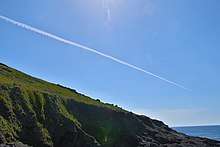
| Contrails | |
|---|---|
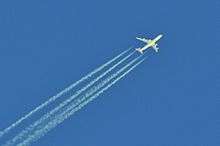 Engine exhaust contrails forming behind a Swiss International Air Lines Airbus A340 | |
| Genus | Cirrus (curl of hair), cirrocumulus, or cirrostratus |
| Altitude | 7,500 to 12,000 m (25,000 to 40,000 ft) |
| Classification | Family A (High-level) |
| Appearance | long bands |
| Precipitation cloud? | No |
Depending on the temperature and humidity at the altitude the contrails form, they may be visible for only a few seconds or minutes, or may persist for hours and spread to be several miles wide, eventually resembling natural cirrus or altocumulus clouds.[1] Persistent contrails are of particular interest to scientists because they increase the cloudiness of the atmosphere.[1] The resulting cloud forms are formally described as homomutatus,[3] and may resemble cirrus, cirrocumulus, or cirrostratus, and are sometimes called cirrus aviaticus.[4] Persistent spreading contrails are suspected to have an effect on global climate.[5][6]
Condensation trails as a result of engine exhaust
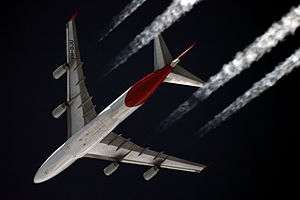
Engine exhaust is predominantly made up of water and carbon dioxide, the combustion products of hydrocarbon fuels. Many other chemical byproducts of incomplete hydrocarbon fuel combustion, including volatile organic compounds, inorganic gases, polycyclic aromatic hydrocarbons, oxygenated organics, alcohols, ozone and particles of soot have been observed at lower concentrations. The exact quality is a function of engine type and basic combustion engine function, with up to 30% of aircraft exhaust being unburned fuel.[7] (Micron-sized metallic particles resulting from engine wear have also be detected.) At high altitudes as this water vapor emerges into a cold environment, the localized increase in water vapor can raise the relative humidity of the air past saturation point. The vapor then condenses into tiny water droplets which freeze if the temperature is low enough. These millions of tiny water droplets and/or ice crystals form the contrails. The time taken for the vapor to cool enough to condense accounts for the contrail forming some distance behind the aircraft. At high altitudes, supercooled water vapor requires a trigger to encourage deposition or condensation. The exhaust particles in the aircraft's exhaust act as this trigger, causing the trapped vapor to condense rapidly. Exhaust contrails usually form at high altitudes; usually above 8,000 m (26,000 ft), where the air temperature is below −36.5 °C (−34 °F). They can also form closer to the ground when the air is cold and moist.[8]
A 2013–2014 study jointly supported by NASA, the German aerospace center DLR, and Canada's National Research Council NRC, determined that biofuels could reduce contrail generation. This reduction was explained by demonstrating that biofuels produce fewer soot particles, which are the nuclei around which the ice crystals form. The tests were performed by flying a DC-8 at cruising altitude with a sample-gathering aircraft flying in trail. In these samples, the contrail-producing soot particle count was reduced by 50 to 70 percent, using a 50% blend of conventional Jet A1 fuel and HEFA (hydroprocessed esters and fatty acids) biofuel produced from camelina.[9][10][11]
Condensation from decreases in pressure
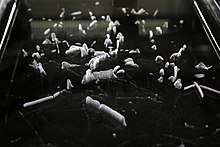
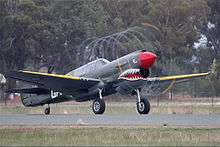
As a wing generates lift, it causes a vortex to form at the wingtip, and at the tip of the flap when deployed (wingtips and flap-boundaries are discontinuities in airflow.) These wingtip vortices persist in the atmosphere long after the aircraft has passed. The reduction in pressure and temperature across each vortex can cause water to condense and make the cores of the wingtip vortices visible. This effect is more common on humid days. Wingtip vortices can sometimes be seen behind the wing flaps of airliners during takeoff and landing, and during landing of the Space Shuttle.
The visible cores of wingtip vortices contrast with the other major type of contrails which are caused by the combustion of fuel. Contrails produced from jet engine exhaust are seen at high altitude, directly behind each engine. By contrast, the visible cores of wingtip vortices are usually seen only at low altitude where the aircraft is travelling slowly after takeoff or before landing, and where the ambient humidity is higher. They trail behind the wingtips and wing flaps rather than behind the engines.
At high-thrust settings the fan blades at the intake of a turbofan engine reach transonic speeds, causing a sudden drop in air pressure. This creates the condensation fog (inside the intake) which is often observed by air travelers during takeoff.
The tips of rotating surfaces (such as propellers and rotors) sometimes produce visible contrails.[12]
Contrails and climate
Contrails, by affecting the Earth's radiation balance, act as a radiative forcing. Studies have found that contrails trap outgoing longwave radiation emitted by the Earth and atmosphere (positive radiative forcing) at a greater rate than they reflect incoming solar radiation (negative radiative forcing). NASA conducted a great deal of detailed research on atmospheric and climatological effects of contrails, including effects on ozone, ice crystal formation, and particle composition, during the Atmospheric Effects of Aviation Project (AEAP).[13] Global radiative forcing has been calculated from the reanalysis data, climatological models and radiative transfer codes. It is estimated to amount to 0.012 W/m² (watts per square meter) for 2005, with an uncertainty range of 0.005 to 0.026 W/m², and with a low level of scientific understanding.[14] Therefore, the overall net effect of contrails is positive, i.e., a warming effect.[15] However, the effect varies daily and annually, and overall the magnitude of the forcing is not well known: Globally (for 1992 air traffic conditions), values range from 3.5 mW/m² to 17 mW/m². Other studies have determined that night flights are mostly responsible for the warming effect: while accounting for only 25% of daily air traffic, they contribute 60 to 80% of contrail radiative forcing. Similarly, winter flights account for only 22% of annual air traffic, but contribute half of the annual mean radiative forcing.[16]
A 2015 study found that artificial cloudiness caused by contrail "outbreaks" reduces the difference between daytime and nighttime temperatures. The former are decreased and the latter are increased, in comparison to temperatures the day before and the day after such outbreaks.[17] On days with outbreaks the day/night temperature difference was diminished by about 6 °F (3.3 °C) in the U.S. South and 5 °F (2.8 °C) in the Midwest.[18]
Further studies have shown that the radiative forcing due to contrail cirrus is the largest known radiative forcing component associated with air traffic, and is larger than the total contribution of CO2 accumulated from aviation since its inception. In 2019 a study predicted that, without interventions, by 2050 the Global contrail cirrus radiative forcing will triple from a baseline in 2006 reaching 160 or even 180 mW/m².[19][20]
September 11, 2001, climate impact study
The grounding of planes for three days in the United States after September 11, 2001, provided a rare opportunity for scientists to study the effects of contrails on climate forcing. Measurements showed that without contrails, the local diurnal temperature range (difference of day and night temperatures) was about 1 °C (1.8 °F) higher than immediately before;[21] however, it has also been suggested that this was due to unusually clear weather during the period.[22]
Condensation trails have been suspected of causing "regional-scale surface temperature" changes for some time.[23][24] Researcher David J. Travis, an atmospheric scientist at the University of Wisconsin-Whitewater, wrote in the science journal Nature that the effect of the change in aircraft contrail formation during the three days after the September 11 attacks was observed in surface temperature change, measured across over 4,000 reporting stations in the continental United States.[23] His research documented an "anomalous increase in the average diurnal temperature change".[23] The diurnal temperature range (DTR) is the difference in the day's highs and lows at any weather reporting station.[25] Travis observed a 1.8 °C (3.2 °F) departure from the two adjacent three-day periods to 11–14 September.[23] This increase was the largest recorded in 30 years, more than "2 standard deviations away from the mean DTR".[23]
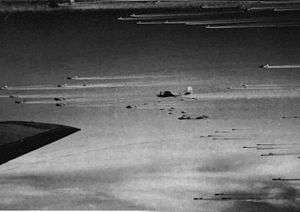
The September 2001 air closures are deeply unusual in the modern world, but similar effects have provisionally been identified from World War II records,[26][27] when flying was more tightly controlled. A 2011 study of climate records in the vicinity of large groups of airbases found a case where contrails appeared to induce a statistically significant change in local climate, with a temperature variance around 0.8 °C (1.4 °F), suggesting that examination of historic weather data could help study these effects.[28]
Head-on contrails
A contrail from an airplane flying towards the observer can appear to be generated by an object moving vertically.[29][30] On 8 November 2010 in the US state of California, a contrail of this type gained media attention as a "mystery missile" that could not be explained by U.S. military and aviation authorities,[31] and its explanation as a contrail[29][30][32][33] took more than 24 hours to become accepted by U.S. media and military institutions.[34]
Distrails
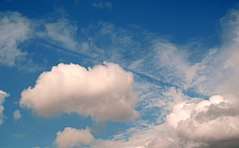
Where an aircraft passes through a cloud, it can disperse the cloud in its path. This is known as a distrail (short for "dissipation trail"). The plane's warm engine exhaust and enhanced vertical mixing in the aircraft's wake can cause existing cloud droplets to evaporate. If the cloud is sufficiently thin, such processes can yield a cloud-free corridor in an otherwise solid cloud layer.[35] An early satellite observation of distrails that most likely were elongated, aircraft-induced fallstreak holes appeared in Corfidi and Brandli (1986).[36]
Clouds form when invisible water vapor (H
2O in gas phase) condenses into microscopic water droplets (H
2O in liquid phase) or into microscopic ice crystals (H
2O in solid phase). This may happen when air with a high proportion of gaseous water cools. A distrail forms when the heat of engine exhaust evaporates the liquid water droplets in a cloud, turning them back into invisible, gaseous water vapor.
Gallery
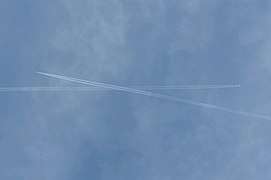 Contrails formed due to two jets crossing over
Contrails formed due to two jets crossing over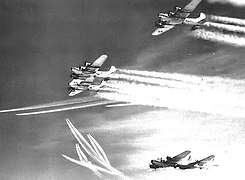 B-17 bombers over Europe, 1944
B-17 bombers over Europe, 1944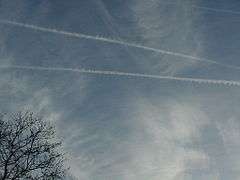 Airliner contrails, some new, some old, dispersed by wind shear
Airliner contrails, some new, some old, dispersed by wind shear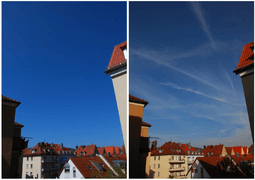 The image on the left shows the sky above Würzburg, Germany without contrails after the grounding of air traffic in 2010 and the image on the right shows the sky with regular air traffic on a day when conditions were right for contrails to form
The image on the left shows the sky above Würzburg, Germany without contrails after the grounding of air traffic in 2010 and the image on the right shows the sky with regular air traffic on a day when conditions were right for contrails to form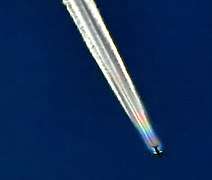 Iridescent contrails from a Boeing 747. This effect happens when sun shines through a group of similarly-sized water droplets at a relatively small angle
Iridescent contrails from a Boeing 747. This effect happens when sun shines through a group of similarly-sized water droplets at a relatively small angle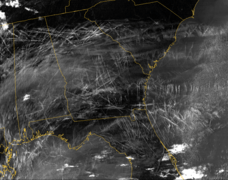 MODIS tracking of contrails generated by air traffic over the southeastern United States on 29 January 2004
MODIS tracking of contrails generated by air traffic over the southeastern United States on 29 January 2004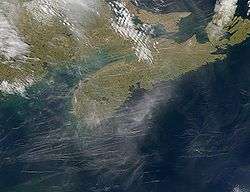 Multiple contrails above Nova Scotia
Multiple contrails above Nova Scotia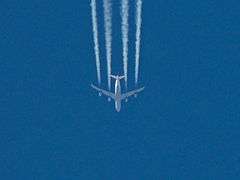 An Airbus A340 of Lufthansa produces contrails
An Airbus A340 of Lufthansa produces contrails- A contrail over southwest Virginia
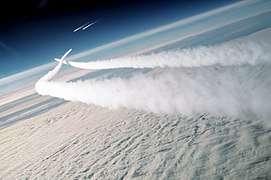 Two USAF F-15s approaching Soviet MiG-29s
Two USAF F-15s approaching Soviet MiG-29s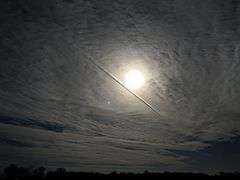 A contrail casting a shadow onto a lower cloud layer
A contrail casting a shadow onto a lower cloud layer.jpg) Contrails in front of the sun
Contrails in front of the sun.jpg)
See also
- Chemtrail conspiracy theory
- Cirrus cloud
- Cloud chamber – particle detector that works on similar principle
- Environmental impact of aviation
- Fallstreak hole
- Global dimming
- Ship tracks
- Skywriting
- Space jellyfish
- Twomey effect
References
- "Aircraft Contrails Factsheet" (PDF). FAA.Gov. Retrieved 13 October 2015.
- "vapour trail". Encyclopædia Britannica. Encyclopædia Britannica Inc. Retrieved 17 April 2012.
- Sutherland, Scott (23 March 2017). "Cloud Atlas leaps into 21st century with 12 new cloud types". The Weather Network. Pelmorex Media. Retrieved 24 March 2017.
- "Cirrus Aviaticus – Cirrus – Names of Clouds". namesofclouds.com.
- Contrails, Cirrus Trends, and Climate Archived 3 March 2016 at the Wayback Machine – joint paper by Patrick Minnis, Atmospheric Sciences, NASA Langley Research Center; J Kirk Ayers, Rabinda Palikonda and Dung Phan, Analytical Services and Materials
- FAA Policies
- Ritchie, Glenn; Still, Kenneth; Rossi Iii, John; Bekkedal, Marni; Bobb, Andrew; Arfsten, Darryl (2003). "Biological and health effects of exposure to kerosene-based jet fuels and performance additives". Journal of Toxicology and Environmental Health, Part B. 6 (4): 357–451. doi:10.1080/10937400306473. PMID 12775519. S2CID 30595016.
- "Contrail Education – FAQ". nasa.gov. Archived from the original on 8 April 2016.
- "The Week in Technology". Aviation Week & Space Technology. 20–24 March 2017. Paper published in Nature, Rich Moore & Hans Schlager, authors.
- Sean Broderick (24 December 2017). "Biofuels Could Reduce Contrail Formation, Research Finds".
- Richard H. Moore; et al. (15 March 2017). "Biofuel blending reduces particle emissions from aircraft engines at cruise conditions" (PDF). Nature. 543 (7645): 411–415. Bibcode:2017Natur.543..411M. doi:10.1038/nature21420. PMID 28300096.
- "Photos from the field". Vertical Magazine, April/May 2014, p. 39. Accessed: 8 July 2014.
- "The Atmospheric Effects of Aviation Project (AEAP)". Archived from the original on 20 May 2000. Retrieved 2 February 2019.
- Lee, D.S.; D.W. Fahey; P.M. Forster; P.J. Newton; R.C.N. Wit; L.L. Lim; B. Owen; R. Sausen (2009). "Aviation and global climate change in the 21st century" (PDF). Atmos. Environ. 43 (22): 3520–7. Bibcode:2009AtmEn..43.3520L. doi:10.1016/j.atmosenv.2009.04.024. PMC 7185790. PMID 32362760.
- Ponater, M.; S. Marquart; R. Sausen; U. Schumann (2005). "On contrail climate sensitivity". Geophysical Research Letters. 32 (10): L10706. Bibcode:2005GeoRL..3210706P. doi:10.1029/2005GL022580. Retrieved 21 November 2008.
- Stuber, Nicola; Piers Forster; Gaby Rädel; Keith Shine (15 June 2006). "The importance of the diurnal and annual cycle of air traffic for contrail radiative forcing". Nature. 441 (7095): 864–867. Bibcode:2006Natur.441..864S. doi:10.1038/nature04877. PMID 16778887.
- Bernhardt, J. & Carleton, A.M. (2015). The impacts of long-lived jet contrail "outbreaks" on surface station diurnal temperature range. Journal of International Climatology. Online-early (July).
- Jet contrails affect surface temperatures. Science Daily. 18 June 2015.
- "It turns out planes are even worse for the climate than we thought". New Scientist.
- Bock, Lisa; Burkhardt, Ulrike (2019). "Contrail cirrus radiative forcing for future air traffic". Atmospheric Chemistry and Physics. 19 (12): 8163–8174. Bibcode:2019ACP....19.8163B. doi:10.5194/acp-19-8163-2019.
- Travis, D.J.; A.M. Carleton; R.G. Lauritsen (March 2004). "Regional Variations in U.S. Diurnal Temperature Range for the 11–14 September 2001 Aircraft Groundings: Evidence of Jet Contrail Influence on Climate" (PDF). J. Clim. 17 (5): 1123–1134. Bibcode:2004JCli...17.1123T. CiteSeerX 10.1.1.497.8060. doi:10.1175/1520-0442(2004)017<1123:RVIUDT>2.0.CO;2. ISSN 1520-0442. Archived from the original (PDF) on 26 February 2009. Retrieved 6 November 2008.
- Kalkstein; Balling Jr. (2004). "Impact of unusually clear weather on United States daily temperature range following 9/11/2001". Climate Research. 26: 1–4. Bibcode:2004ClRes..26....1K. doi:10.3354/cr026001.
- Travis, D.J.; A. Carleton; R.G. Lauritsen (August 2002). "Contrails reduce daily temperature range". Nature. 418 (6898): 601. Bibcode:2002Natur.418..601T. doi:10.1038/418601a. PMID 12167846.
- Only partial content available on-line: Reed, Christina (September 2006). "Hot Trails". Scientific American. news scan. 295 (3): 28. Bibcode:2006SciAm.295c..28R. doi:10.1038/scientificamerican0906-28. ISSN 0036-8733. OCLC 1775222. PMID 16925028.
- Perkins, Sid. "September's Science: Shutdown of airlines aided contrail studies." Science News. Vol. 161, No. 19. p. 291 (11 May 2002). Science News Online
- ClimateWire, Umair Irfan (7 July 2011). "World War II Bomber Contrails Show How Aviation Affects Climate". scientificamerican.com.
- Parry, Wynne (7 July 2011). "WWII Bombing Raids Altered English Weather". livescience.com.
- Ryan, A. C.; MacKenzie, A. R.; Watkins, S.; Timmis, R. (2012). "World War II contrails: A case study of aviation-induced cloudiness". International Journal of Climatology. 32 (11): 1745–1753. Bibcode:2012IJCli..32.1745R. doi:10.1002/joc.2392.
- McKee, Maggie (9 November 2010). "Mystery 'missile' likely a jet contrail, says expert". New Scientist. Archived from the original on 10 November 2010. Retrieved 10 November 2010.
- West, Mick (10 November 2010). "A Problem of Perspective – New Year's Eve Contrail". Archived from the original on 12 November 2010. Retrieved 10 November 2010.
- "Pentagon Can't Explain "Missile" off California". CBS. 9 November 2010. Archived from the original on 10 November 2010. Retrieved 10 November 2010.
- Pike, John E. (November 2010). "Mystery Missile Madness". GlobalSecurity.org. Retrieved 11 November 2010.
- Bahneman, Liem (9 November 2010). "It was US Airways flight 808". Archived from the original on 13 November 2010. Retrieved 10 November 2010.
- "Pentagon: 'Mystery missile' was probably airplane". Mercury News/AP. 10 November 2010. Archived from the original on 12 January 2012. Retrieved 11 November 2010.
- Distrail on Earth Science Picture of the Day Archived 16 October 2002 at the Wayback Machine
- Corfidi, Stephen; Brandli, Hank (May 1986). "GOES views aircraft distrails" (PDF). National Weather Digest. 11: 37–39.
External links
| Wikimedia Commons has media related to Contrails. |
| Look up contrail in Wiktionary, the free dictionary. |
- Contrails.nl: Pictures of contrails and Aviation Cirrus (-Smog), from 1995 on
- Clouds Caused By Aircraft Exhaust May Warm The U.S. Climate
- NASA Astronomy Picture of the Day: Contrails over the USA (13 October 2004)
- Reference site for debunking weird stories about contrails
- Contrail simulator (Java applet) – interactively shows how temperature and humidity of the surrounding air affect contrail formation and characteristics
- NASA Contrail Education
- What is a contrail and how does it form?, National Weather Service
- "Why Planes Make Vapor Trails". Popular Science. 142 (3): 55. March 1943. ISSN 0161-7370.